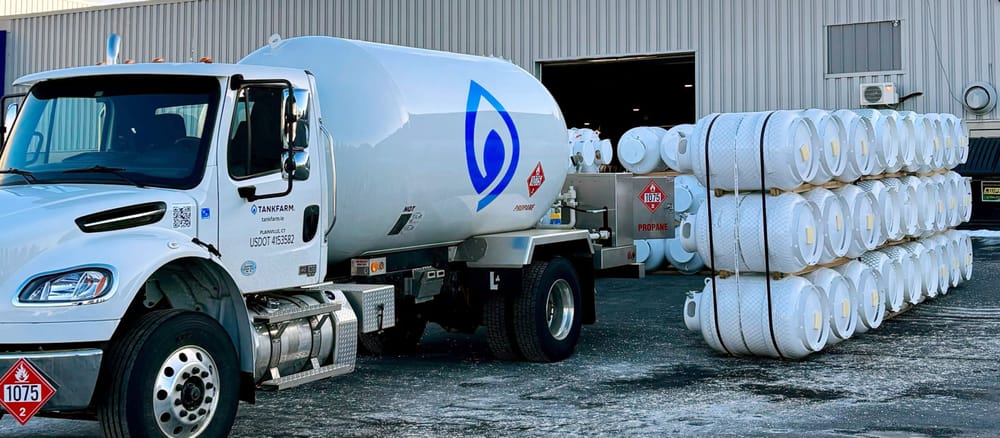Whether you're converting from heating oil, building a new home, or upgrading your existing propane system, one of the most important decisions you’ll make is choosing the right size propane tank. It’s not a one-size-fits-all solution, and the wrong size tank can lead to more frequent refills, higher costs, or even lowered efficiency.
At Tankfarm, we’re here to simplify the process. Let’s break down the factors that go into selecting the right size tank for your home.
Why Tank Size Matters
Choosing the proper propane tank size isn’t just about capacity—it’s about efficiency, convenience, and cost. If your tank is too small, you may run out of fuel during high-demand seasons or require more frequent deliveries. If it’s too large, you could end up spending more than necessary on installation and maintenance.
The right tank size will help ensure:
- Fewer refills
- Better fuel pricing (larger fills = lower cost per gallon)
- Proper system function and safety
- Long-term savings and peace of mind
Common Residential Propane Tank Sizes
Here’s a quick overview of the most common residential propane tank sizes and what they’re typically used for:
🔹 120-Gallon Tank
- Best for: Cooking, clothes drying, small space heating, or backup generators
- Not ideal for: Whole-home heating
- Key features: Installed vertically, takes up less ground space
- Refill frequency: Moderate, depending on usage
🔹 250-Gallon Tank
- Best for: Homes using propane for two or three appliances (like cooking, hot water, and supplemental heating)
- Common in: Smaller homes or secondary residences
- Refill frequency: Every few months, depending on appliance usage
🔹 500-Gallon Tank
- Best for: Whole-home heating and multiple appliances
- Most common size for average-sized homes
- Seasonal usage: Ideal for colder climates with higher winter fuel demands
- Refill frequency: Usually 1–2 times per year
🔹 1,000-Gallon Tank
- Best for: Large homes, multi-family buildings, or homes with pools and outdoor kitchens
- Also common in: Agricultural or light commercial settings
- High capacity: Supports very high usage and long refill intervals
Factors That Influence Tank Size
Every home is different, so there’s no universal “perfect size.” Here’s what we consider when recommending the right propane tank for a home:
Step 1: Evaluate Your Propane Usage
Start by looking at how you plan to use propane:
- Appliances: Heating, water heater, stove, clothes dryer, fireplace, pool heater, generator.
- Primary or supplemental? Whole-home heating will require more capacity than a stove or fireplace.
- Consumption patterns: Already using propane? Review past usage. If you’re new to it, your installer can estimate needs based on appliance BTUs and frequency of use.
Step 2: Consider the Size of Your Home
Larger homes = greater demand. But it’s not just square footage.
- Home size: Homes around 2,500 sq. ft. typically require a 500-gallon tank.
- Occupancy: More people usually means more hot water, more laundry, more cooking—and more fuel.
Step 3: Compare Common Tank Sizes
Here’s a quick guide to the most common residential propane tank sizes:
Step 4: Factor in Climate
Location matters. In colder regions, heating demand increases dramatically in winter. A tank that works in Georgia might not cut it in Vermont. If you’re in a snowbelt state, a larger tank helps reduce winter delivery stress and keeps your home warm when you need it most.
Step 5: Know Your Property Layout and Local Codes
Installation isn’t just about capacity—it’s also about clearances and compliance.
- Smaller tanks (like 120-gallon vertical models) fit tighter spaces.
- Larger tanks (250+ gallons) require more horizontal space and must be placed at least 10 feet from structures or ignition sources.
- Local codes may impact placement, burial options, and tank access.
Tankfarm handles all permitting, code checks, and installation logistics—so you don’t have to.
Step 6: Consider Budget and Delivery Preferences
Larger tanks cost more upfront, but typically offer:
- Lower per-gallon prices
- Fewer deliveries
- Better buffer during peak usage months
If you prefer a set-it-and-forget-it approach, a larger tank paired with smart monitoring gives you peace of mind.
Step 7: Call Tankfarm to Help You Decide
At Tankfarm, we don’t expect homeowners to become propane experts—that’s our job. When you work with us, here’s how we simplify tank sizing and installation:
- Free site surveys: We inspect your property, appliances, and fuel needs to make a personalized recommendation.
- Smart tank monitoring: Every Tankfarm customer benefits from smart monitoring technology. Monitors allow us to track your levels and schedule deliveries automatically.
- No rental or delivery fees: You get the size you need, without hidden costs.
- Fast, safe installation: Our local technicians are trained to install tanks to code, ensuring safety and efficiency.
Frequently Asked Questions
Q: What size propane tank do I need for a 2,000 sq. ft. house? A: For a typical 2,000 sq. ft. home using propane for heating and appliances, a 500-gallon tank is usually recommended.
Q: Can I use a 120-gallon tank for heating my home? A: A 120-gallon tank is not ideal for whole-home heating—it’s better suited for cooking, hot water, or a backup generator.
Q: How long does a 500-gallon propane tank last? A: It depends on usage, but in a typical home, a 500-gallon tank can last 3 to 6 months during peak heating season.
Q: How do I know when to refill my propane tank? A: With Tankfarm, you don’t have to guess. Our wireless monitor tracks your tank level and we schedule refills automatically.
CONCLUSION:
Choosing the right propane tank size can feel overwhelming, but it doesn’t have to be. With Tankfarm you can feel confident knowing your system is designed for safety, comfort, and efficiency.
If you’re not sure where to start, we’ve got you covered. Reach out to Tankfarm today and schedule your free consultation. We’ll help you find the perfect tank for your home.




